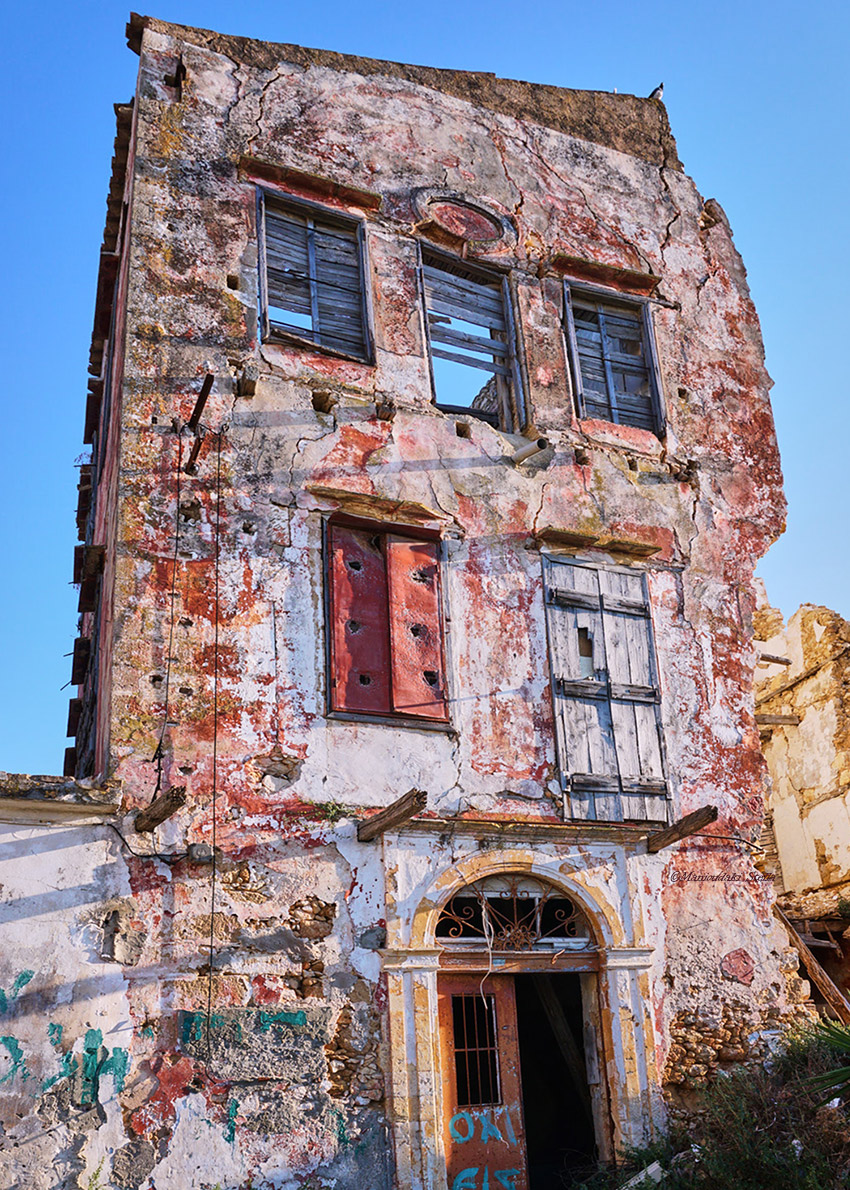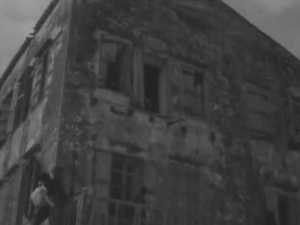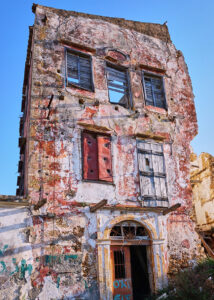The metochi estates: Kokkino Metochi
City
Migration Period
City Narratives
Full Description
Kokkino [Red] Metochi was located in the area neighbouring the Chrysopigi monastery, which is now a suburb of Chania to the south of the city. The name still survives today and is used by the locals to describe the area where the estate, one of the most emblematic in the city, formerly prospered. Its name probably derives from the brick red colour of the metochi manor, traces of which can be discerned in the recent photograph taken by photographer Stella Manioudaki.
The metochi was delimited by a wall with a double arched gate. The gate led to the courtyard, with the auxiliary buildings gathered around the three-story dwelling at the centre. In the mid-18th century, the French traveller Bourqelot described the garden as full of ‘orange trees, hibiscus, lemon trees, colourful bushes, all drawing water from a marble water fountain’. The metochi had an uninterrupted view all the way to the sea.
After the population exchange, the metochi was broken up and used for the rehabilitation of Asia Minor refugees. However, its agricultural character started to change. In 1963, when Michael Cacoyannis used the manor of the metochi to shoot his film Zorba the Greek the building was already in a state of disrepair. Petros Kakogiannis, the son of Asia Minor refugees who received part of the metochi for their housing rehabilitation, remembers that the film producers had to make repairs to a part of the building in order to turn it into the house of Madame Ortance.
The film clip presented in this entry indicates the condition of the dwelling where refugee families still lived. ‘We lived there until the 1970s! Then we left, we abandoned it, the tiles were rotting away, the wood beams were falling… in the end, it just collapsed’. In the specific scene from the film, we can also see the Ottoman water fountain in the courtyard behind the protagonists.
Petros Kakogiannis remembers another incident from the shoot, when unexpectedly he realised that he and the director were related: ‘So I entered the house and there was Michael Cacoyannis… I didn’t know who he was… He says, “What’s your name?”, I say, “Petros”. “Your other name!”, he says. “Kakogiannis”, I answer. “What do you mean Kakogiannis?”. “Our family name is Kakogiannis”, my mother tells him. “Wait, I’ve stumbled across a Kakogiannis family! Any of the old guard still around?”, he asks. “There’s grandma!”, we answer and we call over our poor grandma. “Tell me, how did you end up here?”, he asks her. “I’m from Alatsata, we left Çeşme, went to Chios, from there we got on a boat, made it to Piraeus, from Piraeus we came here, and they gave us this house”. “You don’t have any other relatives from over there?”, he asks. “I do”, she says, “on my husband’s side. One of his brothers left for America, the other went to Cyprus”. Cacoyannis caught on immediately. “That’s where our family lines meet, Cyprus. What was his name?”. “Giorgos”. “And what was he to you?”. “He was my husband’s brother”. That’s when Cacoyannis hugged me and had me jump around and shout his name’.
Ioannis Verdos, another descendant of refugees rehabilitated in the Kokkino Metochi, remembers how he reached the decision to sell his share: ‘It makes me sad, because the house I lived in was old and I was left all alone. I used to live with my mother and when she died, some neighbours came one evening and said: “Sell us the house. We’ll pay you anything you ask for and we will demolish it ourselves”. They had the back part of the land and wanted to build, but I had the front. And that’s what happened. They paid me what I asked for and in the morning they demolished it. Of course, it made me sad because it was the house where I was born but… time passes and the houses, they pass too’.
Another Asia Minor refugee descendant, Nikos Pagiavlas, wrote in this personal blog: ‘Unfortunately, only ruins remain of that three-story house. The heirs and the Municipality of Mournies left it to its fate. After a bout of bad weather in 1997, if memory serves, it started collapsing’. He also offers a vivid description of the enthusiasm the refugees felt when they saw the film production of Zorba the Greek unfold in their neighbourhood. By narrating one of his memories, the writer succinctly depicts the morals and beliefs of these families in the 1960s.
‘In the scene of Madame Ortance’s death and the looting that followed, there were two old women who are the most distinctive characters. They were played by Grandma Verdaina and Grandma Papakastrou. They were a big hit back then. Their girlfriends envied them for being “protagonist actresses”. Especially my grandmother, my father’s mother. Her son didn’t let her get a part in the film. He would have killed her if she had! She never forgave him. I was a toddler then, but I just barely remember her watching the shoot from her doorway and crying her eyes out’.
Nikos Pagiavlas, a second generation Asia Minor refugee born in Kokkino Metochi, introduced himself as the child of an agrarian family, indicating that for some of the refugee families who settled in the metochi estates agricultural rehabilitation indeed proved successful. However, it is important to note that this success did not necessarily extend to all the families that settled in these estates. In any case, Nikos’ father worked as a farmer. Nikos himself became a sailor and returned to the farmlands of Kokkino Metochi in the 1990s, when he decided to become one of the first organic farmers in Chania. Today, the area of Kokkino Metochi is semi-urban and very little agricultural activity still takes place.
Bibliography
Manolis Manousakas, ‘Photo-retrospectives in old Chania. 147: Kokkino Metochi’, Routes supplement, Chaniotika Nea (04/01/2008).
Remembrance. The metochi estates of the Chania plains: what is lost and what remains, directed by: Sofia Kassari (2021)
Interview by Petros Kakogiannis, excerpt from the unedited material for the film Remembrance. The metochi estates of the Chania plains: what is lost and what remains, funded by the Municipal Enterprise for Culture and the Environment of Chania – Centre of Mediterranean Architecture. A Citron Stories production. Researched and Directed by: Sofia Kassari, Camera: Paris Chamourikos, Editing: Konstantinos Thanos, Music: Chrysostomos Gketsis, 2021.
Nikos Pagiavlas, ‘The cinematic house of Madame Ortance’, (25/07/2011) [http://npgls.blogspot.com/2011/07/blog-post_25.html]
‘Nikos Pagiavlas. The first farmer of organic produce in Chania’, Gastronomos (24/01/2011) [https://www.gastronomos.gr/vraveia/vraveia-2010/nikos-pagiaylas/56430/]


